air conditioning CADILLAC STS V 2007 1.G Owners Manual
[x] Cancel search | Manufacturer: CADILLAC, Model Year: 2007, Model line: STS V, Model: CADILLAC STS V 2007 1.GPages: 560, PDF Size: 2.92 MB
Page 231 of 560
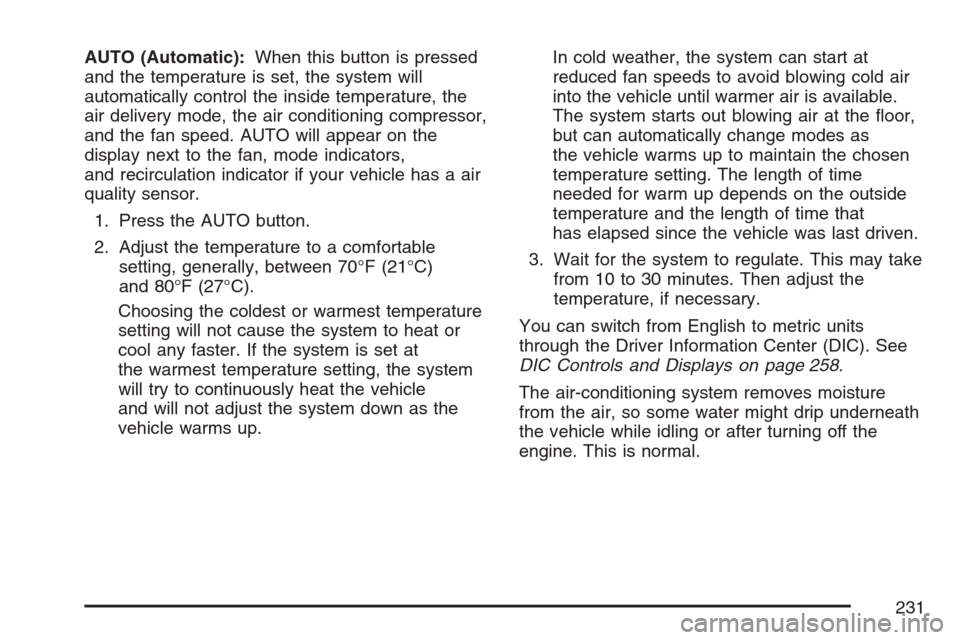
AUTO (Automatic):When this button is pressed
and the temperature is set, the system will
automatically control the inside temperature, the
air delivery mode, the air conditioning compressor,
and the fan speed. AUTO will appear on the
display next to the fan, mode indicators,
and recirculation indicator if your vehicle has a air
quality sensor.
1. Press the AUTO button.
2. Adjust the temperature to a comfortable
setting, generally, between 70°F (21°C)
and 80°F (27°C).
Choosing the coldest or warmest temperature
setting will not cause the system to heat or
cool any faster. If the system is set at
the warmest temperature setting, the system
will try to continuously heat the vehicle
and will not adjust the system down as the
vehicle warms up.In cold weather, the system can start at
reduced fan speeds to avoid blowing cold air
into the vehicle until warmer air is available.
The system starts out blowing air at the �oor,
but can automatically change modes as
the vehicle warms up to maintain the chosen
temperature setting. The length of time
needed for warm up depends on the outside
temperature and the length of time that
has elapsed since the vehicle was last driven.
3. Wait for the system to regulate. This may take
from 10 to 30 minutes. Then adjust the
temperature, if necessary.
You can switch from English to metric units
through the Driver Information Center (DIC). See
DIC Controls and Displays on page 258.
The air-conditioning system removes moisture
from the air, so some water might drip underneath
the vehicle while idling or after turning off the
engine. This is normal.
231
Page 234 of 560
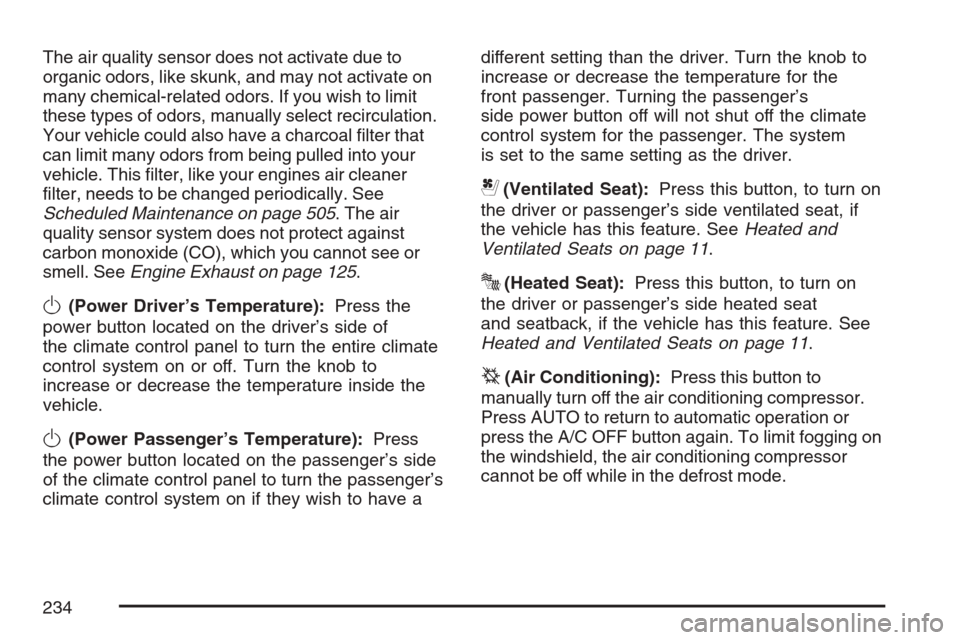
The air quality sensor does not activate due to
organic odors, like skunk, and may not activate on
many chemical-related odors. If you wish to limit
these types of odors, manually select recirculation.
Your vehicle could also have a charcoal �lter that
can limit many odors from being pulled into your
vehicle. This �lter, like your engines air cleaner
�lter, needs to be changed periodically. See
Scheduled Maintenance on page 505. The air
quality sensor system does not protect against
carbon monoxide (CO), which you cannot see or
smell. SeeEngine Exhaust on page 125.
O(Power Driver’s Temperature):Press the
power button located on the driver’s side of
the climate control panel to turn the entire climate
control system on or off. Turn the knob to
increase or decrease the temperature inside the
vehicle.
O(Power Passenger’s Temperature):Press
the power button located on the passenger’s side
of the climate control panel to turn the passenger’s
climate control system on if they wish to have adifferent setting than the driver. Turn the knob to
increase or decrease the temperature for the
front passenger. Turning the passenger’s
side power button off will not shut off the climate
control system for the passenger. The system
is set to the same setting as the driver.
{(Ventilated Seat):Press this button, to turn on
the driver or passenger’s side ventilated seat, if
the vehicle has this feature. SeeHeated and
Ventilated Seats on page 11.
J(Heated Seat):Press this button, to turn on
the driver or passenger’s side heated seat
and seatback, if the vehicle has this feature. See
Heated and Ventilated Seats on page 11.
^(Air Conditioning):Press this button to
manually turn off the air conditioning compressor.
Press AUTO to return to automatic operation or
press the A/C OFF button again. To limit fogging on
the windshield, the air conditioning compressor
cannot be off while in the defrost mode.
234
Page 235 of 560
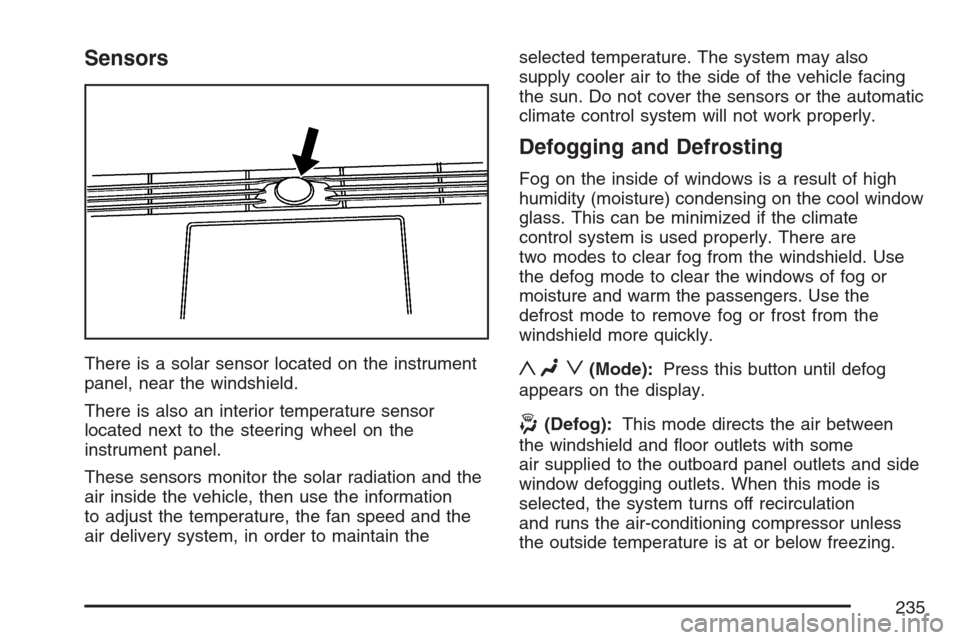
Sensors
There is a solar sensor located on the instrument
panel, near the windshield.
There is also an interior temperature sensor
located next to the steering wheel on the
instrument panel.
These sensors monitor the solar radiation and the
air inside the vehicle, then use the information
to adjust the temperature, the fan speed and the
air delivery system, in order to maintain theselected temperature. The system may also
supply cooler air to the side of the vehicle facing
the sun. Do not cover the sensors or the automatic
climate control system will not work properly.
Defogging and Defrosting
Fog on the inside of windows is a result of high
humidity (moisture) condensing on the cool window
glass. This can be minimized if the climate
control system is used properly. There are
two modes to clear fog from the windshield. Use
the defog mode to clear the windows of fog or
moisture and warm the passengers. Use the
defrost mode to remove fog or frost from the
windshield more quickly.
yNz(Mode):Press this button until defog
appears on the display.
-(Defog):This mode directs the air between
the windshield and �oor outlets with some
air supplied to the outboard panel outlets and side
window defogging outlets. When this mode is
selected, the system turns off recirculation
and runs the air-conditioning compressor unless
the outside temperature is at or below freezing.
235
Page 236 of 560
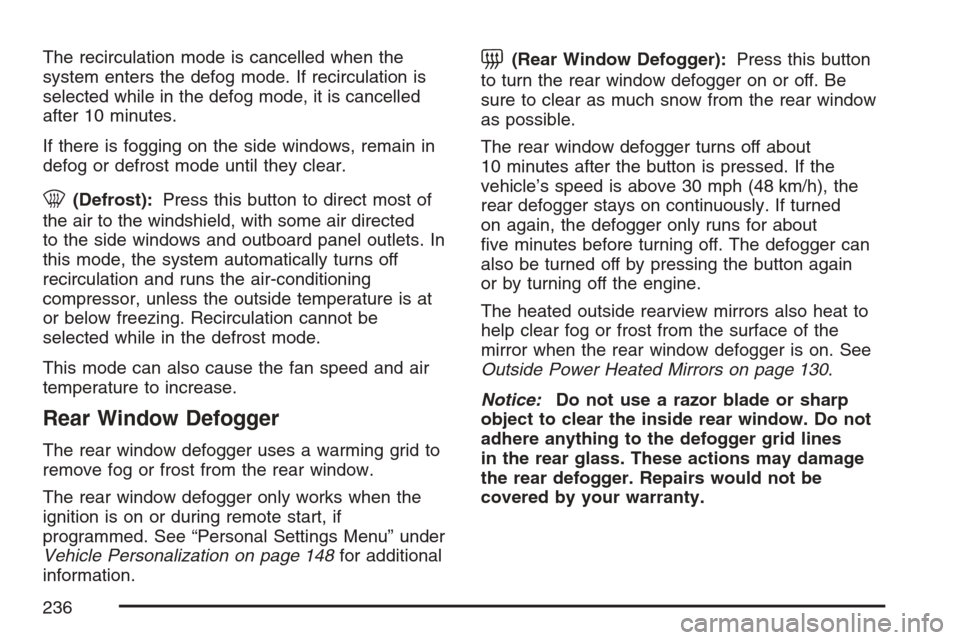
The recirculation mode is cancelled when the
system enters the defog mode. If recirculation is
selected while in the defog mode, it is cancelled
after 10 minutes.
If there is fogging on the side windows, remain in
defog or defrost mode until they clear.
0(Defrost):Press this button to direct most of
the air to the windshield, with some air directed
to the side windows and outboard panel outlets. In
this mode, the system automatically turns off
recirculation and runs the air-conditioning
compressor, unless the outside temperature is at
or below freezing. Recirculation cannot be
selected while in the defrost mode.
This mode can also cause the fan speed and air
temperature to increase.
Rear Window Defogger
The rear window defogger uses a warming grid to
remove fog or frost from the rear window.
The rear window defogger only works when the
ignition is on or during remote start, if
programmed. See “Personal Settings Menu” under
Vehicle Personalization on page 148for additional
information.
=(Rear Window Defogger):Press this button
to turn the rear window defogger on or off. Be
sure to clear as much snow from the rear window
as possible.
The rear window defogger turns off about
10 minutes after the button is pressed. If the
vehicle’s speed is above 30 mph (48 km/h), the
rear defogger stays on continuously. If turned
on again, the defogger only runs for about
�ve minutes before turning off. The defogger can
also be turned off by pressing the button again
or by turning off the engine.
The heated outside rearview mirrors also heat to
help clear fog or frost from the surface of the
mirror when the rear window defogger is on. See
Outside Power Heated Mirrors on page 130.
Notice:Do not use a razor blade or sharp
object to clear the inside rear window. Do not
adhere anything to the defogger grid lines
in the rear glass. These actions may damage
the rear defogger. Repairs would not be
covered by your warranty.
236
Page 269 of 560
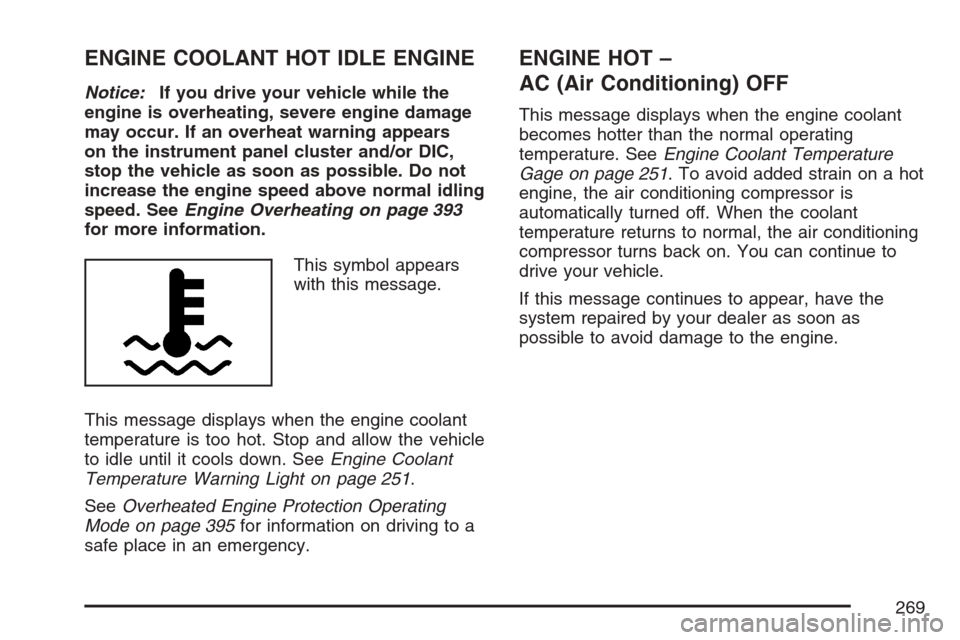
ENGINE COOLANT HOT IDLE ENGINE
Notice:If you drive your vehicle while the
engine is overheating, severe engine damage
may occur. If an overheat warning appears
on the instrument panel cluster and/or DIC,
stop the vehicle as soon as possible. Do not
increase the engine speed above normal idling
speed. SeeEngine Overheating on page 393
for more information.
This symbol appears
with this message.
This message displays when the engine coolant
temperature is too hot. Stop and allow the vehicle
to idle until it cools down. SeeEngine Coolant
Temperature Warning Light on page 251.
SeeOverheated Engine Protection Operating
Mode on page 395for information on driving to a
safe place in an emergency.
ENGINE HOT –
AC (Air Conditioning) OFF
This message displays when the engine coolant
becomes hotter than the normal operating
temperature. SeeEngine Coolant Temperature
Gage on page 251. To avoid added strain on a hot
engine, the air conditioning compressor is
automatically turned off. When the coolant
temperature returns to normal, the air conditioning
compressor turns back on. You can continue to
drive your vehicle.
If this message continues to appear, have the
system repaired by your dealer as soon as
possible to avoid damage to the engine.
269
Page 274 of 560
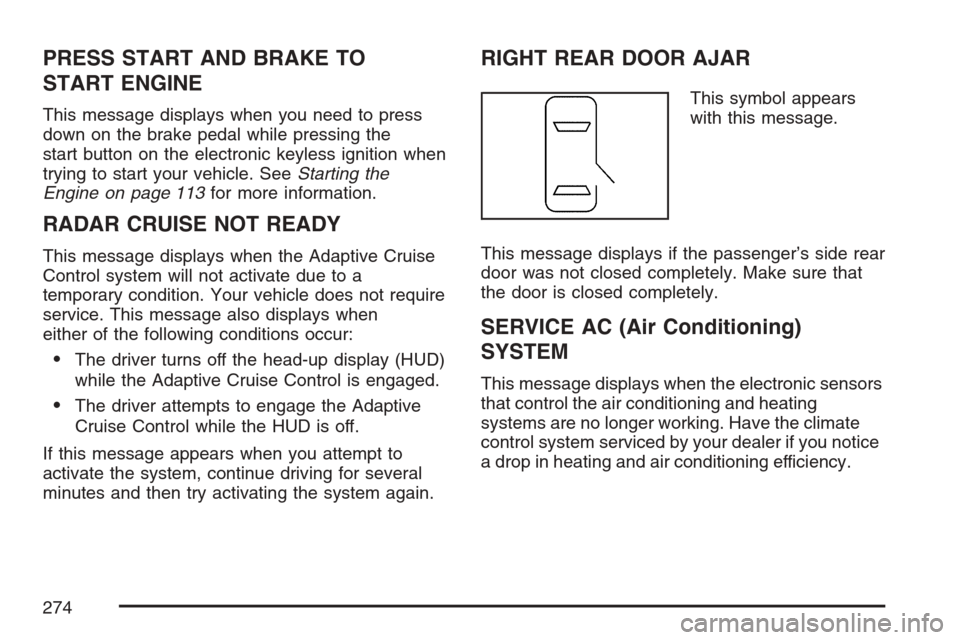
PRESS START AND BRAKE TO
START ENGINE
This message displays when you need to press
down on the brake pedal while pressing the
start button on the electronic keyless ignition when
trying to start your vehicle. SeeStarting the
Engine on page 113for more information.
RADAR CRUISE NOT READY
This message displays when the Adaptive Cruise
Control system will not activate due to a
temporary condition. Your vehicle does not require
service. This message also displays when
either of the following conditions occur:
The driver turns off the head-up display (HUD)
while the Adaptive Cruise Control is engaged.
The driver attempts to engage the Adaptive
Cruise Control while the HUD is off.
If this message appears when you attempt to
activate the system, continue driving for several
minutes and then try activating the system again.
RIGHT REAR DOOR AJAR
This symbol appears
with this message.
This message displays if the passenger’s side rear
door was not closed completely. Make sure that
the door is closed completely.
SERVICE AC (Air Conditioning)
SYSTEM
This message displays when the electronic sensors
that control the air conditioning and heating
systems are no longer working. Have the climate
control system serviced by your dealer if you notice
a drop in heating and air conditioning efficiency.
274
Page 426 of 560
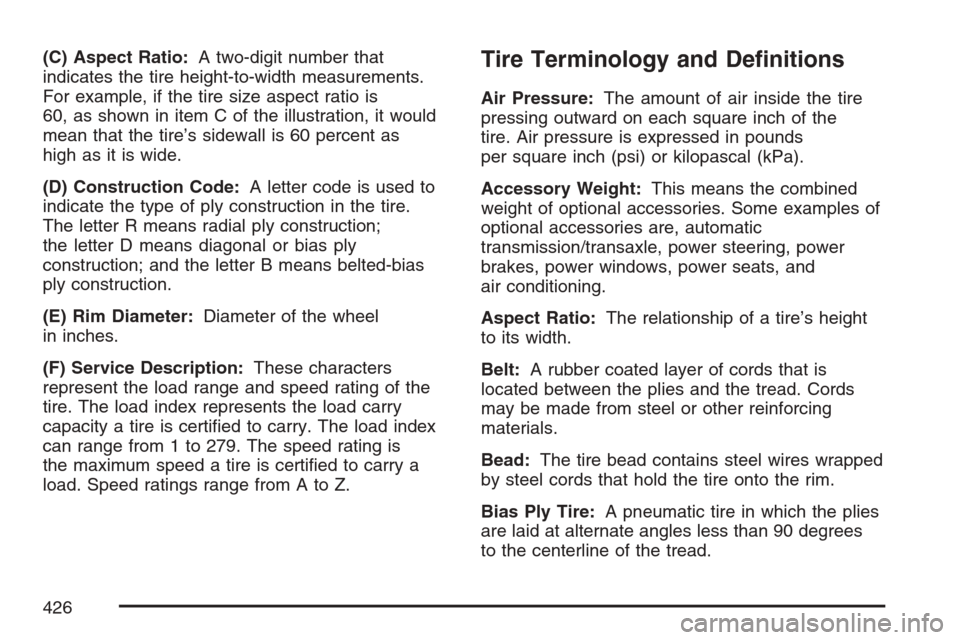
(C) Aspect Ratio:A two-digit number that
indicates the tire height-to-width measurements.
For example, if the tire size aspect ratio is
60, as shown in item C of the illustration, it would
mean that the tire’s sidewall is 60 percent as
high as it is wide.
(D) Construction Code:A letter code is used to
indicate the type of ply construction in the tire.
The letter R means radial ply construction;
the letter D means diagonal or bias ply
construction; and the letter B means belted-bias
ply construction.
(E) Rim Diameter:Diameter of the wheel
in inches.
(F) Service Description:These characters
represent the load range and speed rating of the
tire. The load index represents the load carry
capacity a tire is certi�ed to carry. The load index
can range from 1 to 279. The speed rating is
the maximum speed a tire is certi�ed to carry a
load. Speed ratings range from A to Z.Tire Terminology and De�nitions
Air Pressure:The amount of air inside the tire
pressing outward on each square inch of the
tire. Air pressure is expressed in pounds
per square inch (psi) or kilopascal (kPa).
Accessory Weight:This means the combined
weight of optional accessories. Some examples of
optional accessories are, automatic
transmission/transaxle, power steering, power
brakes, power windows, power seats, and
air conditioning.
Aspect Ratio:The relationship of a tire’s height
to its width.
Belt:A rubber coated layer of cords that is
located between the plies and the tread. Cords
may be made from steel or other reinforcing
materials.
Bead:The tire bead contains steel wires wrapped
by steel cords that hold the tire onto the rim.
Bias Ply Tire:A pneumatic tire in which the plies
are laid at alternate angles less than 90 degrees
to the centerline of the tread.
426
Page 490 of 560
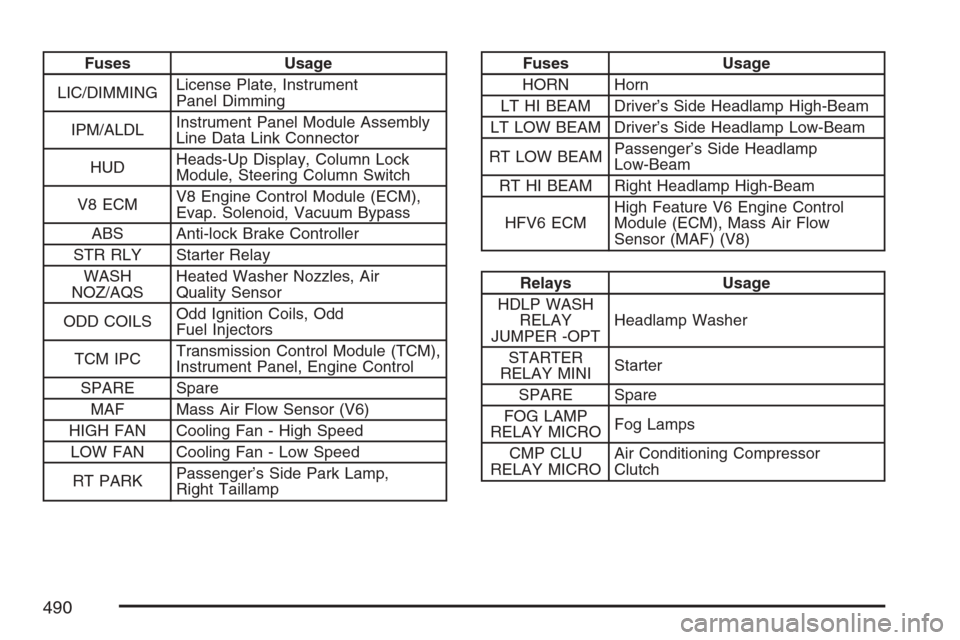
Fuses Usage
LIC/DIMMINGLicense Plate, Instrument
Panel Dimming
IPM/ALDLInstrument Panel Module Assembly
Line Data Link Connector
HUDHeads-Up Display, Column Lock
Module, Steering Column Switch
V8 ECMV8 Engine Control Module (ECM),
Evap. Solenoid, Vacuum Bypass
ABS Anti-lock Brake Controller
STR RLY Starter Relay
WASH
NOZ/AQSHeated Washer Nozzles, Air
Quality Sensor
ODD COILSOdd Ignition Coils, Odd
Fuel Injectors
TCM IPCTransmission Control Module (TCM),
Instrument Panel, Engine Control
SPARE Spare
MAF Mass Air Flow Sensor (V6)
HIGH FAN Cooling Fan - High Speed
LOW FAN Cooling Fan - Low Speed
RT PARKPassenger’s Side Park Lamp,
Right TaillampFuses Usage
HORN Horn
LT HI BEAM Driver’s Side Headlamp High-Beam
LT LOW BEAM Driver’s Side Headlamp Low-Beam
RT LOW BEAMPassenger’s Side Headlamp
Low-Beam
RT HI BEAM Right Headlamp High-Beam
HFV6 ECMHigh Feature V6 Engine Control
Module (ECM), Mass Air Flow
Sensor (MAF) (V8)
Relays Usage
HDLP WASH
RELAY
JUMPER -OPTHeadlamp Washer
STARTER
RELAY MINIStarter
SPARE Spare
FOG LAMP
RELAY MICROFog Lamps
CMP CLU
RELAY MICROAir Conditioning Compressor
Clutch
490
Page 498 of 560
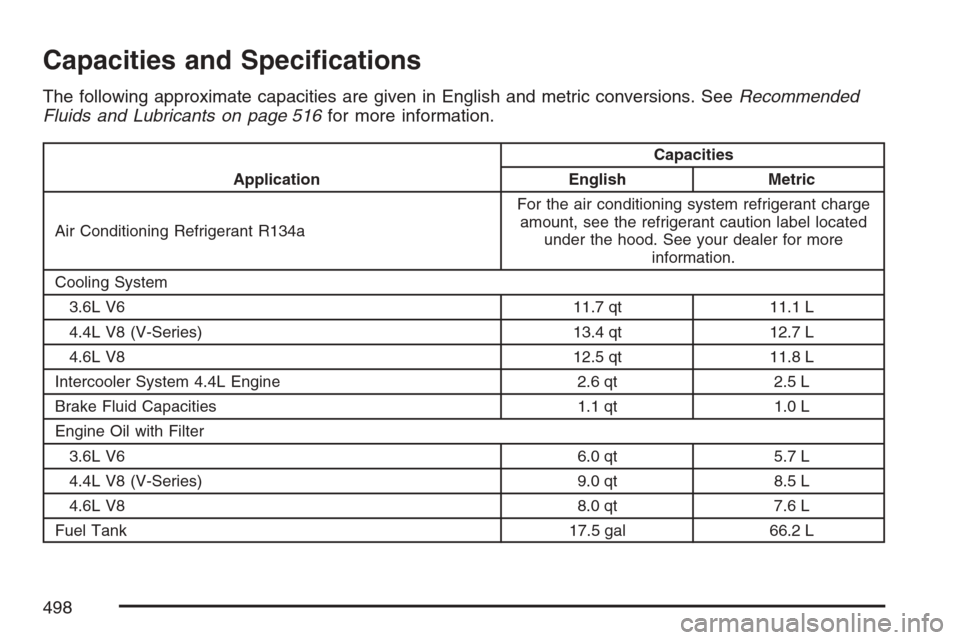
Capacities and Speci�cations
The following approximate capacities are given in English and metric conversions. SeeRecommended
Fluids and Lubricants on page 516for more information.
ApplicationCapacities
English Metric
Air Conditioning Refrigerant R134aFor the air conditioning system refrigerant charge
amount, see the refrigerant caution label located
under the hood. See your dealer for more
information.
Cooling System
3.6L V6 11.7 qt 11.1 L
4.4L V8 (V-Series) 13.4 qt 12.7 L
4.6L V8 12.5 qt 11.8 L
Intercooler System 4.4L Engine 2.6 qt 2.5 L
Brake Fluid Capacities 1.1 qt 1.0 L
Engine Oil with Filter
3.6L V6 6.0 qt 5.7 L
4.4L V8 (V-Series) 9.0 qt 8.5 L
4.6L V8 8.0 qt 7.6 L
Fuel Tank 17.5 gal 66.2 L
498
Page 510 of 560
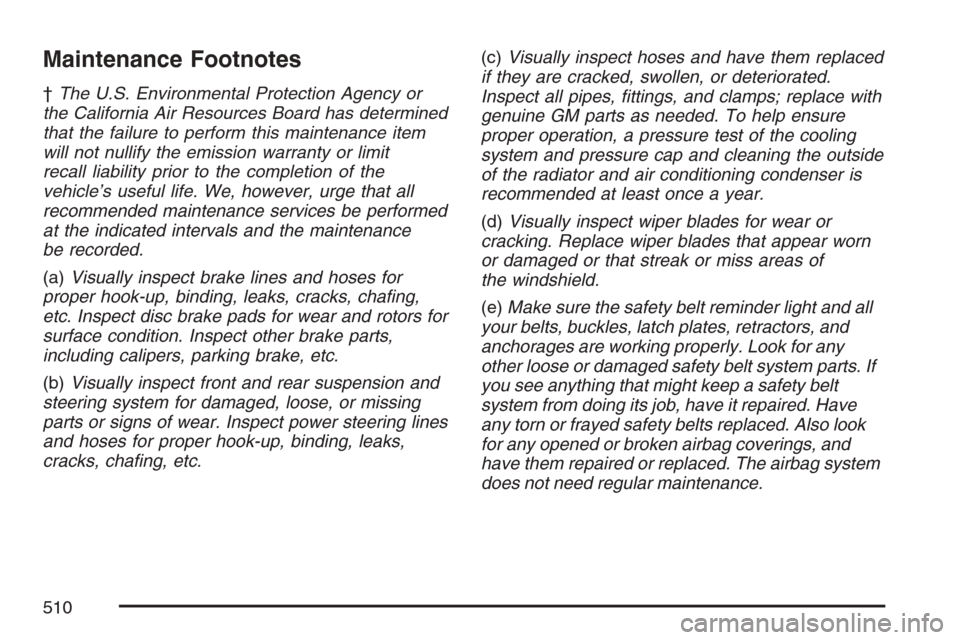
Maintenance Footnotes
†The U.S. Environmental Protection Agency or
the California Air Resources Board has determined
that the failure to perform this maintenance item
will not nullify the emission warranty or limit
recall liability prior to the completion of the
vehicle’s useful life. We, however, urge that all
recommended maintenance services be performed
at the indicated intervals and the maintenance
be recorded.
(a)Visually inspect brake lines and hoses for
proper hook-up, binding, leaks, cracks, cha�ng,
etc. Inspect disc brake pads for wear and rotors for
surface condition. Inspect other brake parts,
including calipers, parking brake, etc.
(b)Visually inspect front and rear suspension and
steering system for damaged, loose, or missing
parts or signs of wear. Inspect power steering lines
and hoses for proper hook-up, binding, leaks,
cracks, cha�ng, etc.(c)Visually inspect hoses and have them replaced
if they are cracked, swollen, or deteriorated.
Inspect all pipes, �ttings, and clamps; replace with
genuine GM parts as needed. To help ensure
proper operation, a pressure test of the cooling
system and pressure cap and cleaning the outside
of the radiator and air conditioning condenser is
recommended at least once a year.
(d)Visually inspect wiper blades for wear or
cracking. Replace wiper blades that appear worn
or damaged or that streak or miss areas of
the windshield.
(e)Make sure the safety belt reminder light and all
your belts, buckles, latch plates, retractors, and
anchorages are working properly. Look for any
other loose or damaged safety belt system parts. If
you see anything that might keep a safety belt
system from doing its job, have it repaired. Have
any torn or frayed safety belts replaced. Also look
for any opened or broken airbag coverings, and
have them repaired or replaced. The airbag system
does not need regular maintenance.
510